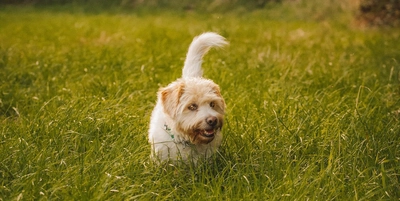How to Do a Dog Health Check at Home
- 31 May 2023
- 12m read
.jpg)
Typically, dogs require a vet check up once a year but there are a few simple things you can do at home in-between visits. We recommend performing these checks on your dog as often as you can. This will help to ensure that anything out of the ordinary is spotted and dealt with quickly.
Video: How to perform a health check on your dog at home
What Does a Dog Health Check Include?
An easy way to remember how to perform a health check on your dog is to embrace your inner child with a recital of heads, shoulders, knees and toes. Not forgetting the eyes and ears and mouth and nose, of course.
Performing a health check on your dog at home won’t be as thorough as when it is done by a vet, but nevertheless they’re still vitally important to make sure that your dog is displaying all the signs of being fighting fit.
From head to tail, here are the things that you should be checking:
• Body condition and vital signs
• Eyes, ears, nose and mouth
• Abdomen
• Skin and coat
• Muscles and joints
• Teeth and gums
• Paws and nails
Checking Your Dog’s Body Condition Score
Checking a dog's body condition score is an essential part of assessing their overall health and well-being. Here are the steps to follow to check a dog's body condition score:
1. Stand over your dog and look down at their back. You should be able to see an hourglass figure where the waist is narrower than the chest and hips.
2. Run your hands over your dog's rib cage. You should be able to feel their ribs without pressing too hard. If you can't feel their ribs, they may be overweight. Likewise, the ribs should not be protruding too much and should have a thin layer of fat to protect them.
3. Place your hands on the dog's back and feel for the backbone. You should be able to feel the bones without pressing too hard. If the backbone is difficult to feel or you can't feel it at all, the dog may be overweight. Similarly to their ribs, the backbone should not be sticking out too much.
4. Look at your dog from the side. The abdomen should be tucked up and you should be able to see a slight upward slope from the ribcage to the hips.
Based on these observations, you can assign a body condition score to your dog using a scale of 1 to 9. A dog with a body condition score of 5 is considered to be at an ideal weight. A score of 1-3 indicates the dog is underweight, while a score of 6-9 suggests the dog is overweight or obese.
Check out our handy guide below.
Checking Your Dog’s Vital Signs
Checking your dog's vital signs regularly is an important part of monitoring their health. Here are the steps to follow to check your dog's vital signs:
Heart rate
Place your hand on the left side of your dog's chest, just behind their elbow, to feel for their heart beat. Count the number of beats you feel in 15 seconds and then multiply that number by four to get your dog's heart rate per minute. A healthy adult dog's heart rate should be between 60-120 beats per minute, but this can vary depending on your pooch’s breed, age and level of activity.
Respiratory rate
Check your dog's breathing by placing your hand on their side to feel movement, counting the number of breaths they take in one minute. A healthy adult dog's respiratory rate should be between 10-30 breaths per minute.
Gum Colour
Lift your dog's lip gently to check the colour of the gums. Healthy gums are typically pink, although some breeds may have black or pigmented gums. Press a finger against the gum and release to check the capillary refill time. The colour should return to the pressed area within 1 to 2 seconds.
Pale or blue gums and prolonged capillary refill time may indicate an underlying health issue, you should double check this with your vet immediately.
How to Check Your Dog’s Temperature
Checking your dog's temperature is an important part of monitoring their health. Here's how you can check your dog's temperature at home:
1. Get together all of the necessary supplies, including a digital rectal thermometer, water-based lubricant and alcohol wipes.
2. Prepare the thermometer by turning it on and making sure it's set to Celcius or Fahrenheit, depending on your preference. Apply a small amount of lubricant to the tip of the thermometer. This is a really important step that will help to reduce your pooch’s discomfort.
3. Have someone to help you hold your dog still and calm during the procedure. If they can talk to your dog during the procedure that would be an added bonus.
4. Gently lift your dog's tail to expose their bottom. They aren’t going to like this next part, so be prepared for a sudden jump and potentially a squeal. We’re sorry pooches, we promise it’s for your own good.
5. Carefully insert the thermometer into your dog's bottom, about an inch or so, depending on the size of your dog. Hold the thermometer in place until it beeps or until the reading is complete (usually less than one minute).
6. Remove the thermometer and wipe it clean with an alcohol wipe to get rid of any bacteria.
7. Record the temperature and note the time it was taken. It might also be helpful to make a note of any additional factors that may have an influence on your dog’s temperature.
How to Check Your Dog’s Eyes
Some breeds, particularly flat-faced ones such as Shih Tzu’s and Pugs, are more prone to eye problems as they have very shallow eye sockets, which makes their eyes bulge slightly. They are also likely to experience regular discharge from the eyes, so it’s important to gently bathe them regularly.
Here are the steps to follow to check your dog's eyes:
1. Stand in a well-lit area and look directly at your dog's eyes. They should be clear and bright, and there should be no visible discharge or redness.
2. Lift your dog's eyelids gently and look at the whites of the eyes. They should be white or slightly pink, with no yellowing or redness.
3. Look at the pupils in both eyes. They should be the same size and react equally to light. To check if the pupils are reacting to light, shine a light in one eye and then the other. The pupils should constrict (get smaller) in response to the light.
4. Gently lift your dog's eyelids and check for any signs of redness, swelling, or discharge. Make sure the eyelids are properly aligned and not turned inward or outward.
5. Watch for any signs of squinting, tearing, or pawing at the eyes, as these may be signs of irritation or infection. Dogs may also scrub their face along the floor, or on bedding, if their eyes are irritated.
How to Check Your Dog’s Ears
In order to make sure that their ears remain able to activate super-sonic hearing mode, you should carry out regular checks. Here are the steps to follow to check your dog's ears:
1. Stand in a well-lit area and look at your dog's ears. They should be clean, pink, and free of discharge or foul odour.
2. Smell your dog's ears to check for any unusual odour, which may indicate an ear infection.
3. Gently rub your fingers around the base of your dog's ears and behind the ear flaps. Check for any signs of redness, swelling, or discharge.
4. Watch for any signs of discomfort, such as your dog shaking their head, scratching at their ears, or rubbing their ears on the ground.
5. Gently lift your dog's earflap and examine the ear canal. It should be clean and free of debris, and the skin should be pink and healthy-looking.
6. Repeat these steps on your dog's other ear.
How to Check Your Dog’s Nose
Checking your dog's nose regularly is an important part of monitoring their health, too. Here are the steps to follow to check your dog's nose:
1. Your dog's nose should be moist and free of any cracking or scabbing. The colour of the nose varies depending on the breed, but it should be consistent and not change dramatically over time.
2. Watch for any discharge from your dog's nose, such as mucus or blood.
3. Watch for any changes in your dog's behaviour, such as sneezing, coughing, or rubbing their nose excessively.
4. Bad breath can be a sign of dental disease or other health issues.
5. In addition to changes in the nose, watch for any other signs of illness, such as lethargy, loss of appetite, or vomiting.
How to Check Your Dog’s Mouth and Teeth
Smile and say cheeeeese. 1 in every 8 dogs suffer from dental disease every year so keeping a close eye on their dental health is really important to prevent this from happening. Here are the steps to follow to check your dog's mouth and teeth:
1. Gently lift your dog's lips to examine their teeth and gums. Look for any signs of redness, swelling, bleeding, or discharge.
2. Check for any tartar buildup on your dog's teeth. Tartar is a hard, yellow-brown material that can accumulate on the teeth, leading to dental disease.
3. Examine your dog's teeth for any broken, cracked, or missing teeth.
4. Bad breath can be a sign of dental disease or other health issues.
5. Watch for any changes in your dog's behaviour, such as reluctance to eat or chew on toys, excessive drooling, or pawing at their mouth.
If you think that there is something wrong with your dog’s mouth or teeth, consult your vet. They can provide advice on how to properly care for your dog's teeth and recommend any necessary medical treatments, such as dental cleanings or extractions.
Regular dental care, including daily tooth brushing and annual dental cleanings, can also help prevent dental disease and maintain your dog's overall health.
Is My Dog’s Skin and Coat Healthy?
Some dogs really have the hair we all envy, full of volume and shine. Keeping their skin healthy is essential for promoting a healthy coat. Here are the steps to follow to check your dog's skin and coat:
1. Your dog's coat should be shiny, soft, and free of any mats or tangles. Check for any bald patches or areas of thinning hair.
2. Look for any signs of fleas or ticks on your dog's skin, such as black specks or tiny insects crawling on the skin.
3. Gently part your dog's fur and examine their skin. Look for any signs of redness, swelling, scabs, or bumps.
4. Feel for any lumps or growths under the skin. Note their size, shape, and location.
5. Observe your dog's behaviour: Watch for any changes in your dog's behaviour, such as excessive itching, licking, or biting at their skin.
6. A strong, unpleasant odour can be a sign of skin infection.
What Should My Dog’s Paws and Nails Look Like?
Whilst they don’t need to get a mani-pedi, you should keep your dog's paws and nails in good condition so that they can enjoy walkies to a maximum. Here are the steps to follow to check your dog's paws and nails:
1. Check your dog's paw pads for any signs of cuts, cracks, or foreign objects such as thorns or glass shards.
2. Check for any swelling or redness around the paw or between the toes.
3. Examine your dog's nails for any signs of cracking, splitting, or infection. Long nails can also cause discomfort or affect your dog's gait.
4. Regular nail trimming is important to maintain your dog's paw health. Trim your dog's nails with a proper nail clipper or grinder.
5. Watch for any changes in your dog's behaviour, such as limping or reluctance to walk.
If you notice any abnormalities in your dog's paws or nails or have any concerns about their health, it's important to consult a veterinarian for further evaluation and treatment. Your vet can provide advice on how to properly care for your dog's paws and nails and recommend any necessary medical treatments, such as antibiotics or pain relief medication.
Regular paw and nail care, including trimming and cleaning, can help maintain your dog's overall paw health.
How Much is a Health Check for a Dog UK?
The price of health checks for dogs in the UK can vary massively depending on a number of factors, such as veterinary practice and whether or not any actions need to be taken.
Typically this will range upwards from £25 to an unlimited cost, if treatments such as vaccinations or flea and worming are needed.
For an exact cost, contact your local vet surgery.
How Often Should I Take My Dog to the Vet?
The frequency of vet visits can vary massively depending on a dog’s individual basis, including their age and whether or not they have any underlying health conditions. In general, it is recommended that your dog receives an annual check up at least once a year. This usually coincides with their annual vaccinations.
Butternut Box’s 24/7 Vet Nurse Helpline
All Butternut Box customers have access to our 24/7 vet nurse helpline. Our team is on hand to help you with whatever queries you may have, no matter how big or small they may be.
If you’ve carried out a health check on your dog and there are some abnormalities that you’re worried about, don’t hesitate to get in touch with us, or your vet.




